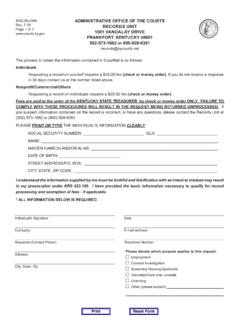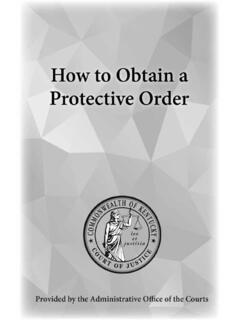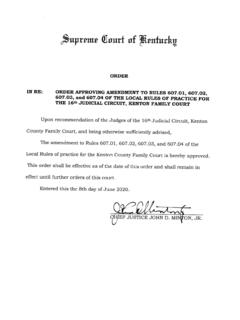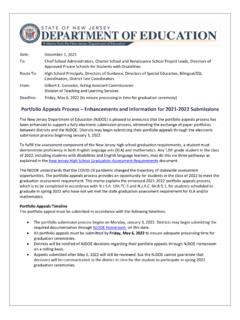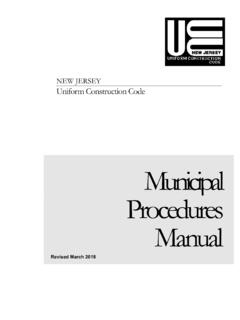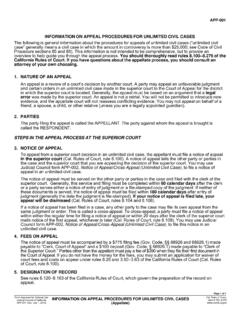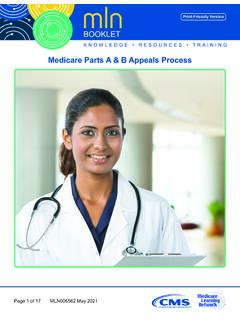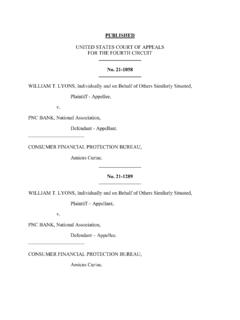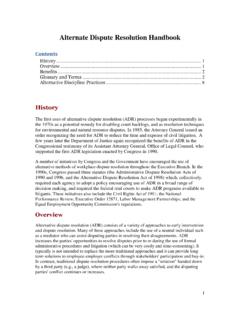Transcription of Basic Appellate Practice Handbook,
1 Basic Appellate Practice handbook , Fourth Edition Chief Judge Denise G. Clayton, Kentucky Court of AppealsThe Kentucky Court of Appeals is pleased to present a revision of the Basic Appellate Practice handbook . We first introduced the handbook in 2006 to address the needs of self-represented litigants who are proceeding without an attorney (pro se) and to assist at-torneys whose Practice does not normally involve work before our Court. The handbook proved to be so successful that we are now releasing this updated fourth handbook is designed to explain the most Basic procedures and concepts for the lay litigant, as well as to summarize succinctly the numerous rules governing Appellate Practice for attorneys embark-ing into what may be a new area of expertise.
2 Consequently, this publication runs the gamut from simplicity to some measure of so-phistication and undoubtedly represents an ambitious endeavor. It is our hope that it will continue to assist many in facilitating their access to the Court of AppreciationWe extend our appreciation to retired Court of Appeals Judge Dan-iel T. Guidugli and his staff attorney, Lisa Hubbard, for their work on the original handbook , which was published in 2006; to George Fowler, former Chief Staff Attorney for the Court, who played a key role in producing the first handbook and in revising it for the second edition in 2007; and to Sam Givens, former Clerk of the Court, Ann Swain, former Chief Staff Attorney, and Lisa Thurman, former ad-ministrative assistant to the legal department of the Court, for their work on the third edition in to this fourth edition were made by Judge Joy A.
3 Kramer, during her tenure as Chief Judge of the Court; Judge Pamela R. Good-wine; Becky Lyon, Clerk of the Court; Sam Givens, former Clerk of the Court; Wes Deskins, Chief Staff Attorney; and Mary Hora, one of my staff attorneys. On behalf of the Court and all who will benefit from the 2020 edition, I express sincere thanks for their dedication and hard of Contents Introduction & Cautionary Notes 1 The Kentucky Court of Appeals 3 Motion Practice & Formatting and Filing Documents 4 What May Be Appealed 9 Notice of appeal 13 Family Court Appeals Expedited by Rule 17 Prehearing Conference Procedure 18 Record on appeal 22 The Brief: Written Argument 25 Submission & Consideration of Appeals 31 Decisions of the Court 34 Petitions for Rehearing & Motions to Reconsider 37 Further Review in the Supreme Court 40 Final Disposition of Appeals 41 Abbreviations & Glossary 43 Checklist for Appellant s Brief 45 Checklist for Appellee s Brief 47 Checklist for Appellant s Reply Brief 491 Introduction & Cautionary Notes The Court of Appeals Basic Appellate Practice handbook is an introducto-ry guide to completing the steps in the Appellate process as it pertains to the Kentucky Court of Appeals.
4 The handbook provides citations to the rules and explains how to use the rules. It is not designed to be a complete Practice manual and is not a substitute for carefully re-viewing the current Kentucky Rules of Civil Procedure (CR) regard-ing appeals. Note: It is the responsibility of a person practicing an appeal to have access to a current set of the rules and to follow those rules. In any apparent conflict between the rules and this handbook , the rules will 2020 revision of this handbook includes references to rules that were current as of January 1, 2020. Copies of the current version of the rules are available in most coun-ty law libraries and in some larger public libraries. To access West s Compilation of Court Rules & procedures online, visit the Kentucky Court of Justice website at and click on Rules & Proce-dures in the Resources section of the Supreme Court or Court of Appeals page.
5 This handbook deals only with the procedures for practicing an ap-peal to the Court of Appeals from a judgment in a case originally filed in circuit court. Various types of cases have special procedures for Appellate review that will preempt the general procedures set out in this guide. A partial list of such special procedures is detailed in the section titled, What May Be Appealed. It is the responsibility of the person practicing the appeal to be knowledgeable about any special procedures that might govern the type of action involved in that appeal . While the staff of the Court of Appeals will always attempt to be helpful and to assist all parties to the extent possible, members of the staff are not allowed to give legal advice or to make decisions for a party concerning how an appeal should be practiced.
6 Members of the staff should not be asked for legal advice or for advice about what a party should do in a given situation. Parties practicing an appeal should research questions in the statutes and the court rules. 2 This handbook is available on the Kentucky Court of Justice website at Click on Court of Appeals, then on Basic Appel-late Practice handbook in the Resources section of the page. Any comments concerning the contents, clarity, or usefulness of this handbook should be addressed by letter to: Chief Staff Attorney Kentucky Court of Appeals 360 Democrat Drive Frankfort, Kentucky 406013 The Kentucky Court of Appeals In 1975, a group of amendments to the Kentucky Constitution (com-monly known as the Judicial Article, Sections 109 through 124) creat-ed a new intermediate Appellate court called the Kentucky Court of Appeals.
7 Prior to that time, the Court of Appeals designation applied to Kentucky s highest court. When the Judicial Article went into effect on January 1, 1976, Kentucky s highest court became known as the Supreme Court of Kentucky and the Court of Appeals com-menced operations. Creation of an intermediate Appellate court was necessitated by in-creased litigation, which had imposed a very heavy work load on the Commonwealth s highest court, resulting in long delays for litigants. Section 115 of the Kentucky Constitution affords litigants a constitu-tional right to one appeal in each action. The new intermediate ap-pellate court not only helped effectuate this right of appeal , but also decreased the time in which Appellate review could be obtained. The intermediate Court of Appeals consists of 14 judges elected by the citizens of the seven Supreme Court districts defined by KRS The two judges from each district maintain offices within the district from which they were elected.
8 The judges are elected for eight-year terms. The current members of the Court can be found on the Court of Justice website at Click on Court of Ap-peals and then on a picture of a judge for more information about them. The members of the Court of Appeals exercise statewide authority and sit in panels of three in various locations across the Common-wealth. Assignment of the judges to hear appeals is among the re-sponsibilities of the Chief Judge of the Court, who is elected by the members of the central office of the Court, including the office of the Clerk of the Court, is located in Frankfort. You can contact the Court at the following address and phone number: Kentucky Court of Appeals 360 Democrat Drive Frankfort, Kentucky 40601 502-573-7920 4 Motion Practice & Formatting and Filing Documents Parties present their arguments on the merits of an appeal through formal briefs.
9 However, in the course of an appeal it may be neces-sary to request rulings from the Court on procedural or substantive issues. These may include simple requests for additional time to file a document required by the rules, complex requests for a stay of en-forcement of the judgment, or even dismissal of the appeal . These requests are handled through the Court s motion Practice . Motion Practice Motion Practice before the Court of Appeals is different from similar Practice before the circuit court in that the parties do not appear at a set motion hour. It is therefore extremely important that the written motion and objections be carefully prepared to present the parties positions. Only in rare cases does the motion panel hear oral argu-ments on motions. CR (5). Any party is permitted to file a response to a motion within 10 days of the date of service of the motion.
10 CR (2). The motion is held in the Clerk s office for the running of the response time. If the motion was served on a party by mail or electronic service, three additional days are added to the response time for that party. CR Note: Motions are the only documents filed in the Court of Appeals for which the response time runs from the date of service. Therefore, this is the only instance in Appellate Practice where CR applies. After the response time has run or after all responses have been filed, the motion is screened to determine proper handling. Motions re-questing any type of substantive relief are assigned to three-judge panels of the Court. Procedural motions requiring any application of judicial discretion are assigned to the Chief Judge or a member of the Court chosen by the Chief Judge.

